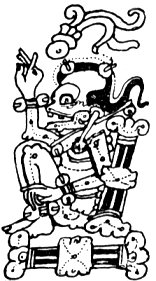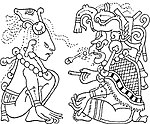Maya death rituals
This article needs additional citations for verification. (April 2016) |
Death rituals were an important part of Maya religion. The Maya greatly respected death; they were taught to fear it and grieved deeply for the dead. They also believed that certain deaths were more noble than others.
Background
The Maya were ritualistic people, who paid great respect to the destructive nature of their gods. They had many traditions to commemorate the recently deceased and worship long-departed ancestors.
People who died by suicide, sacrifice, complications of childbirth and in battle were thought to be transported directly into heaven.
Before Spanish influence, there may not have been a common idea of the afterlife. The Yucatec Maya believed that there were different routes after death. A pot from a Pacal tomb depicts ancestors of Maya kings sprouting through the earth like fruit trees and together creating an orchard. The Maya had several forms of ancestor worship. They built idols containing ashes of the dead and brought them food on festival days. Alternatively, a temple could be built over an urn. In those that were sacrificed, the most common way was cutting the abdomen, and taking out the heart.
Customs
The Maya dead were laid to rest with maize placed in their mouth. Maize, highly important in Maya culture, is a symbol of rebirth and also was food for the dead for the journey to the otherworld. Similarly, a jade or stone bead placed in the mouth served as currency for this journey. Often, whistles carved from rocks into the shapes of gods or animals were included in the grave offerings to help the deceased find their way to Xibalba. The Maya associated the color red with death and rebirth and often covered graves and skeletal remains with cinnabar. The bodies of the dead were wrapped in cotton mantles before being buried. Burial sites were oriented to provide access to the otherworld. Graves faced north or west, in the directions of the Maya heavens, and others were located in caves, entrances to the underworld.
Burial practices of the Maya changed over the course of time. In the late Preclassic period, people were buried in a flexed position, later the dead were laid to rest in an extended position. In the late Classic period, the elite constructed vaulted tombs, and some rulers ordered the construction of large burial complexes. In the Postclassic period, cremation became more common.
Beliefs about the afterlife

The Maya believe that the soul is bound to the body at birth. Only death or sickness can part the body and soul, with death being the permanent parting. To them, there is an afterlife that the soul reaches after death.[1] In that, deceased ancestors can still contact their descendants, answering advice when they are asked. This contact can be used at certain times in the season, or when certain family matters pertain to the ancestors. Understanding the perception of what the deceased do in their afterlife can give ideas towards what rituals need to be performed and what types of items one must be buried with in order to successfully navigate the afterlife.
Reincarnation
The aspect of reincarnation is one strongly mentioned in Mayan beliefs and religion. The Popol Vuh gives importance to the Maize deity, and how the Mayan people themselves descended from maize people created by this god. In the Popol Vuh that the Kʼicheʼ Maya wrote, one of the few surviving codices, it tells the story of the reincarnation of the Maize god. In the tale, the maize god retreats to the underworld and with two hero twins battling the monsters and lords of the place, makes way back to the earthen world. He is reborn again, dies, and on and on the cycle continues. In this aspect, it is believed by the Mayans that the Earth itself is a living being. As they came from corn, consuming corn or having sex then brings one closer to the earth.
Ideas about the afterlife
The concept of the afterlife, or Xibalba, differs between the Mayan ethnic groups. Many have a generalized belief of all souls going to the afterlife, being reincarnated or having another role to participate in after death, but these ideas change dramatically with the rise of Christianity. With that came the idea of Xibalba being a location of punishment. The longer one spent in Xibalba, the worse a life they led while living. With this belief, heaven became a paradise for many to strive for. The Chontal of Tabasco are an example of this.[2]
Ethnic groups
To the Awakateko and the Chuj, the ancestors remain in contact and have the ability to affect the affairs of the living even in death. The Awakateko believed that the afterlife is a place where all ancestors remain, and that there is nowhere to pass on to.[3] But to the Chuj, any contracts made with the dead are binding. If one does not follow these contracts, the ancestor can plague the one bound to the contract with illness or misfortune. To Them, they can contact their ancestors at altars, caves, or places connected to Mayan societies. The association of caves to the underworld is one intertwined with the older Mayan civilization and is an aspect continued by the Chuj people.[4]
There are other ethnic groups that believe ritual items are needed in order to make the journey into the afterlife. The Lakandon bury their people facing the sun, and wrapped in a tunic and hammock.[5] Qʼeqchiʼ bury their dead in a straw sleeping mat, with a hat, sandals and a net provided to help in the journey to the afterlife.[6] In others it was believed a dog was needed to help make the journey through the afterlife. Often a dog was ritually sacrificed, or an effigy buried along with the deceased in order to complete this task.[7] Usually, the goods buried with the person were what the tribe believed was needed to complete one's cross into the next, whether it be the afterlife, heaven or reincarnation.
Other ethnic groups believed that the spirits of the dead still had tasks to complete in the afterlife. The Mam, before fully accepting Christian values thought that the dead lived within volcanoes and other places.[8] To the Tzʼutujil, souls of the dead might be reincarnated or go to assist in moving the sun across the sky. The Tzʼutujil in Santiago feared that souls of drowning victims inhabited the bottom of Lake Atitlan.[9] With this difference in the idea of what one's ancestor does in death, came a change in how and what they were buried with. Those who still had a journey or a task may need more or less items, and it depended on how those of the tribe believed on what occurred after death.
But many ethnic groups also observed a celebration of their deceased ancestors later on. The Poqomam gather after death and hold a feast that may last for nine days. Then they pray for that deceased person every day of the dead for the next seven years.[10] The Tzotzil of Chamula also have a similar holiday for celebrating the dead, though theirs occurs every year. Their belief is that souls return to visit and partake of food once a year, in a celebration called Kʼin Santo. The family members must perform a ritual to the deities to ask release of the souls of their dead relatives and to allow them entrance into the house.[11]
Tombs
There have been many archaeological discoveries of lavish tombs within ceremonial complexes from the Classic period. However, only a Maya city's most important ruler was buried in this way. These aristocrats were placed in tombs at the bottoms of funerary pyramids that sometimes consisted of nine stepped platforms, perhaps symbolizing the nine layers of the underworld. Other temples were constructed with 13 vaults symbolizing the layers of the heavens in Maya cosmology. These temples reflected the continued worship of these nobles. In some instances, members of the royal family or young attendants would be sacrificed to accompany the lord in death.
The tombs were filled with precious goods including fine polychrome pottery, effigy figurines, jade and marble pieces, masks, mushroom figures. While these figures were found in Maya tombs, many of these items were also used in the service of food, drink and for additional ritual purposes.[12] Obsidian and exotic shells have also been found in Mayan tombs. In the Tomb of the Red Queen inside Temple XIII in Palenque, the remains of a noble woman and all the objects inside the sarcophagus were completely covered with bright red vermilion dust, made of ground cinnabar, perhaps intended to suggest blood, the symbol of life.
Other elite members of society were buried in vaults. The bodies of higher-ranking members of society were buried inside sarcophagi. They sometimes were buried in crypts or underneath the family home. These funerary constructions of the royal often destroyed the residence itself. Commoners were also buried near or under their houses. These graves did not have extensive burial offerings, but often contained objects that identified the individual: a tool or possession.
References
- ^ Weider, R. (1998). Encyclopedia of Cultures and Daily Life. Detroit, MI: Gale Research. p. 290.
- ^ Knowles-Berry, Susan M. (1995). Encyclopedia of World Cultures. Vol. 8, Middle Americas and the Caribbean. Boston, Massachusetts: G.K. Hall and Co. p. 69.
- ^ Barber, Kathlene (1995). Encyclopedia of World Cultures. Vol. 8, Middle Americas and the Caribbean. Boston, Massachusetts: G.K. Hall and Co. p. 17.
- ^ Maxwell, Judith M. (1995). Encyclopedia of World Cultures. Vol. 8, Middle Americas and the Caribbean. Boston, Massachusetts: G. K. Hall and Co. p. 74.
- ^ Dow, James W. (1995). Encyclopedia of World Cultures. Vol. 8, Middle Americas and the Caribbean. Boston, Massachusetts: G. K. Hall and Co. p. 154.
- ^ Dow, James W. (1995). Encyclopedia of World Cultures. Vol. 8, Middle Americas and the Caribbean. Boston, Massachusetts: G.K. Hall and Co. p. 227.
- ^ Mythologies. Vol. 1. p. 1189.
- ^ Watanabe, John M. (1995). Encyclopedia of World Cultures. Vol. Vol. 8, Middle Americas and the Caribbean. Boston, Massachusetts: G.K. Hall and Co. p. 160.
{{cite book}}:|volume=has extra text (help) - ^ Carlsen, Robert S. (1995). Encyclopedia of World Cultures. Vol. 8, Middle Americas and the Caribbean. Boston, Massachusetts: G.K. Hall and Co. p. 298.
- ^ Mast, Ian (1995). Encyclopedia of World Cultures. Vol. 8, Middle Americas and the Caribbean. Boston, Massachusetts: G.K. Hall and Co. p. 218.
- ^ Rosenbaum, Brenda (1995). Encyclopedia of World Cultures. Vol. 8, Middle Americas and the Caribbean. Boston, Massachusetts: GK. Hall and Co. p. 281.
- ^ Birmingham Museum of Art (2010). Birmingham Museum of Art : guide to the collection. [Birmingham, Ala]: Birmingham Museum of Art. p. 84. ISBN 978-1-904832-77-5.
Further reading
- Bunson, Margaret R., and Stephen M. Bunson. "Death rituals, Maya." Encyclopedia of Ancient Mesoamerica. New York: Facts On File, Inc., 1996.
- Foster, Lynn V. Handbook to Life in the Ancient Maya World. New York: Facts on File, Inc., 2001.
- Gallenkamp, Charles. Maya: The Riddle and Rediscovery of a Lost Civilization. New York: David McKay Company, Inc, 1976.
- Dow, James W. Encyclopedia of World Cultures
- Weider, R. Encyclopedia of Cultures and Daily Life, edited by Timothy L. Gall. Gale Research Detroit, MI.


